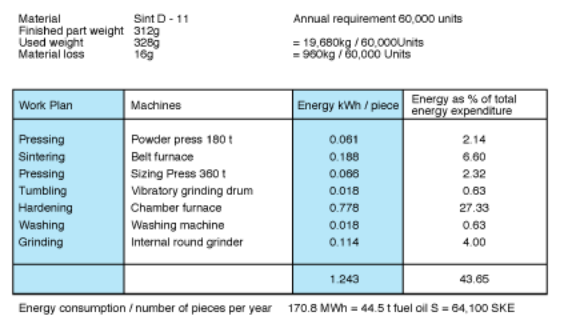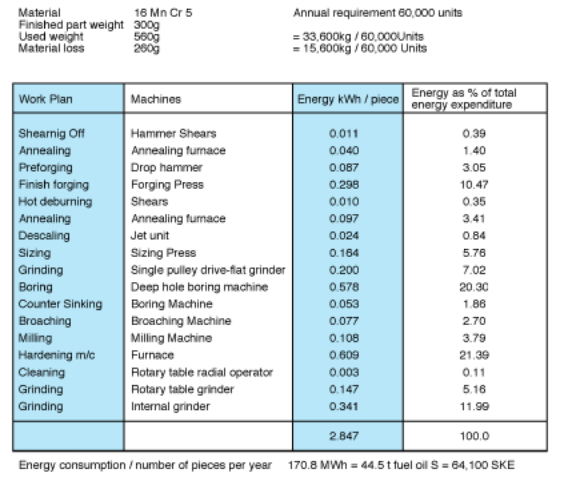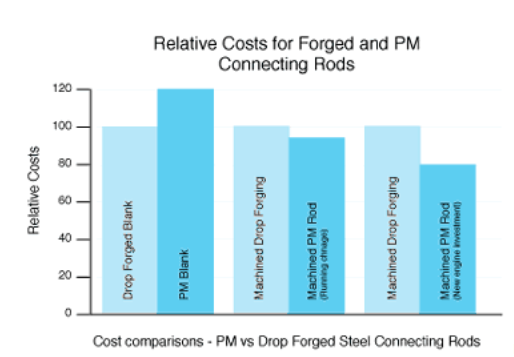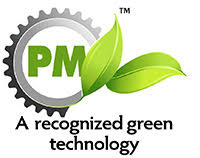There are a variety of ways that powdered metals (the raw material for PM parts) are produced, but the predominate method is atomization. A good explanation of the atomization process can be found in Powdered Metallurgy Review Magazine:
“Atomisation involves the disintegration of a thin stream of molten metal through the impingement of high energy jets of a fluid (liquid or gas). Water is the most commonly used liquid in atomisation.
Water atomised iron powders also have irregular particle shape and therefore good green strength. Unlike sponge iron, the individual powder particles do not contain internal porosity and, because of extensive development of the annealing process, have superior compressibility (see section on Forming processes). Water atomised powders are therefore the material of choice where high green density is sought in PM structural parts.”
For more information on the production of powdered metals please see:
http://www.pm-review.com/introduction-to-powder-metallurgy/powder-production-technologies/
An extremely wide array of metals can be made through the PM process. In principle, the technique is applicable to all metals that can be melted and is used commercially for the production of iron; copper; alloy steels; brass; bronze; low-melting-point metals such as aluminum, tin, lead, zinc, and cadmium; and, in selected instances, tungsten, titanium, rhenium, and other high-melting-point materials.
With proper engineering and material selection, PM material properties can match up well with your needs. Please see our materials selector to understand the strength, elongation and other engineering data that will help you choose the right material for your application.
While the design of PM is very flexible, it does require that the compact has no undercuts and is able to be ejected from a die cavity. We suggest reviewing our industry website https://www.pickpm.com/design-resource-center/design-considerations/ to help you tailor your component design to the PM process. Or feel free to contact our sales team for help with the design process.
PM tooling can cost as little as a few thousand dollars for a very simple shape to $30,000 for large and complex part with many levels. Typically tooling costs between $5,000 and $15,000 for most parts that are tooled in PM.
Reach out and talk to a member of our sales team to help evaluate your component design to determine its feasibility and tooling cost.
We tool parts for as little as 500 pieces annually and have some parts that we run millions each year. Each of our plants is set up to handle either “short-run PM”, “normal PM” or “high-volume PM”.
We would define run sizes as follows:
Short-run PM → 500 to 10,000 pieces
Normal-run PM → 10,000 to 100,000 pieces
High-volume PM → 100,000 to 10,000,000 pieces
Talk to our sales team to help determine which of our PM operations is the best fit for you.
Copper infiltration is a method that is commonly used in PM to fill the open porosity in a steel PM compact in an effort to either increase the strength of the part or to seal porosity for a pneumatic or hydraulic application (or both). An article in Industrial Heating Magazine has a good technical definition of the infiltration process:
“Infiltration is basically defined as "a process of filling the pores of a sintered or unsintered compact with a metal or alloy of a lower melting point." In the particular case of copper infiltrated iron and steel compacts, the base iron matrix, or skeleton, is heated in contact with the copper alloy to a temperature above the melting point of the copper, normally within the range of 2000¯ to 2100¯F (1095¯ to 1150¯C). Through capillary action, the molten copper alloy is drawn into the interconnected pores of the skeleton and ideally fills the entire pore volume”
For further information on copper infiltration, you can read more through this link:
PM parts are readily and regularly machined with success. If you plan to machine your PM component, it would be beneficial to discuss this with our sales team. Typically we will plan to add manganese sulfide (MnS), plastic impregnation or copper infiltration to the process if machining is required.
If you would like more information, please see this attached white paper on machining PM.
PM is known for its ability to hold tight tolerances and to maintain them over the long run. Typically in the direction of pressing on a pressed and sintered compact we can hold +/-0.004” (0.1mm) and +/-0.2% in the die direction. Please call our sales team to discuss more in detail for your application.
For additional information, please read this industry white paper on PM tolerances.









